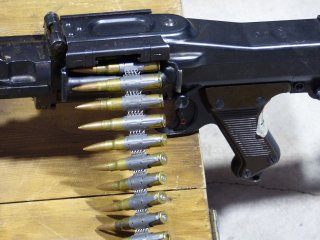How the Nazis's MG 34 Left a Lasting Impact on Firearm History
The MG 34 design continued to be manufactured until the end of the war.
Here's What You Need to Know: Germany’s Bundeswehr still fields the MG3 general-purpose machine gun. Though the design has been modernized somewhat, its not too bad for something that is approaching a century in age.
The MG 34 design originated in Germany during the interwar period preceding both world wars. Up until World War II, machine guns had typically been water-cooled—and correspondingly heavy and immobile. Efforts to build an air-cooled machine gun design produced the MG 13. Though superseded by the improved MG 34, the design was revolutionary.
On to War
German infantry tactics depended on the MG 34 (and similar but later production MG 42) to increase a squad’s available firepower. Unlike the United States, which issued the semi-automatic M1 Garand and the fully-automatic Thompson submachine gun, many German infantry troops were armed with bolt-action rifles like the Karabiner 98k. This tactic meant that MG gunners provided the majority of a squad’s offensive firepower, with individual riflemen keeping them supplied with ammunition.
The MG 34’s unique trigger acted as a fire selector switch. If pulled near the top, the MG fired single shots, whereas fully automatic fire was possible by pulling the trigger from the bottom. Later production MG 34s had an astounding rate of fire—some as high at 1,700 rounds per minute. This awesome rate of fire earned the MG 34 platform the designation “Hitler’s Buzzsaw” due to the gun’s loud, saw-like sound.
Sustained fully-automatic fire was used sparingly, as MG barrels could overheat during extended firefights, posing a danger to the shooter. In order to remedy overheating problems, both the MG 34 and MG 42 were issued with an additional barrel that could be swapped out. In the hands of a skilled operator barrel switches could be done quite quickly and did not significantly hamper the MG’s rate of fire.
Ultimately the design was replaced by the MG 42. Though the MG 42 didn’t offer much of an improvement in performance, it relied on cheaper materials and simpler manufacturing methods. Production simplification allowed a greater number of machine guns to be more rapidly issued to frontline soldiers, though the MG 34 design continued to be manufactured until the end of the war.
Postscript
The design continues to be relevant today. Germany’s Bundeswehr still fields the MG3 general-purpose machine gun. Though the design has been modernized somewhat, it is still issued with iron sights rather than a more modern aiming optic and is chambered in the 7.62x51mm NATO round. In keeping with its general-purpose machine gun heritage, the MG3 is mounted to a number of German vehicles as a secondary armament, and on the infantry squad level. Not too bad for a design that is approaching a century in age.
Caleb Larson is a defense writer for the National Interest. He holds a Master of Public Policy and covers U.S. and Russian security, European defense issues, and German politics and culture.
This article first appeared in 2020 and is being reposted due to reader interest.
Image: Wikimedia Commons

